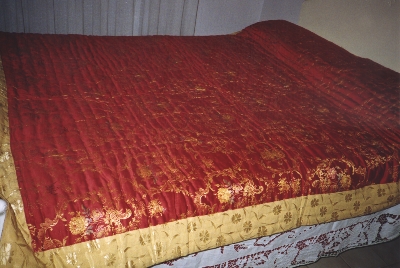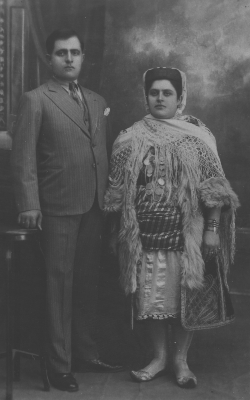Quilt No.917AK - Ann Kyranis

2150 x 1720mm
The quilt was made by Maria Efstathis in El Arish, Queensland in the 1950s. It was made for her daughter, Ann Kyranis, who has been the only owner. It is not used now.
"From Kastellorizo to Queensland
Ann Kyranis' lovely 'paploma' (quilt) was one of several made by Maria (Pitsonis) Efstathis. Maria was the only daughter in her family on the tiny Greek island of Kastellorizo, and married Eleftheri Efstathis on his return there in 1933, to find a bride. He had been in Australia for several years, working with his brothers in the Liberty Cafe in the small north Queensland town of Tully. This had enabled him to provide his new bride with a brand new house, a traditional 'Queenslander'. Other women, at that time, were not so fortunate, arriving from their beautiful Mediterranean island to 'dirt floors in the cane cutting barracks'! Many Greek men from Kastellorizo were employed in the cane fields, as well as in cafes - their women endured the pain and isolation of coming to a new country and very difficult living conditions. Maria was always thankful for her new house and for the company of other Kastellorizian women.
For Maria, it was unthinkable that her three daughters should marry without a traditional 'paploma'(quilt) in their 'prika' (dowry or trousseau). But to make this happen in this remote place was an enormous challenge. For two of the quilt tops, Maria used a patterned brocade piece, a 'stoffa', which she had purchased in Alexandria, Egypt, when travelling to Australia. The gold and dusty-pink brocades were bought somewhere more local; as were a huge number of rolls of cottonwool - probably from the local chemist, as there were no supermarkets then. This was Maria's practical solution to the problem of having no raw cotton to use as padding.
To make each quilt, Maria would carefully unroll the cottonwool and its paper lining (about 9" or 23 cms wide) inside the sewn casing, then, just as carefully, would remove the long strips of paper, leaving behind the thin layer of cottonwool. With these many layers in place, came the laborious task of handstitching the design all over the quilt. An enormous labour of love - all done 'on the wooden floors in the heat of north Queensland!'
Ann, the oldest of Maria's five children, at age eighteen married Agapitos (Jack) in Cairns. Sadly, Jack died at a young age leaving Ann with their two sons, James John and Terry John. Now there are five grandchildren - James and Irene have Anna Jane, Jonathan and Stephen; Terry and Katina have Jake and Ann-Marie.
Over the years, Ann has been very involved with various organisations, particularly in connection with St. George Greek Orthodox Church. She has made a very important contribution to the development of the Greek community in Brisbane by founding the Hellenic Dancers in 1977, and working with them until 1999, her particular interest and responsibility were the authentic Greek costumes worn by the dancers.
Ann regards her 'paploma' with its associated memories and stories, as a tribute to her mother Maria."
[Written by Lula Saunders, adapted from interview 6/9/00 for the National Quilt Register]


Related Quilts:
1620 x 1180mm
1850 x 1100mm
2440 x 2150mm






